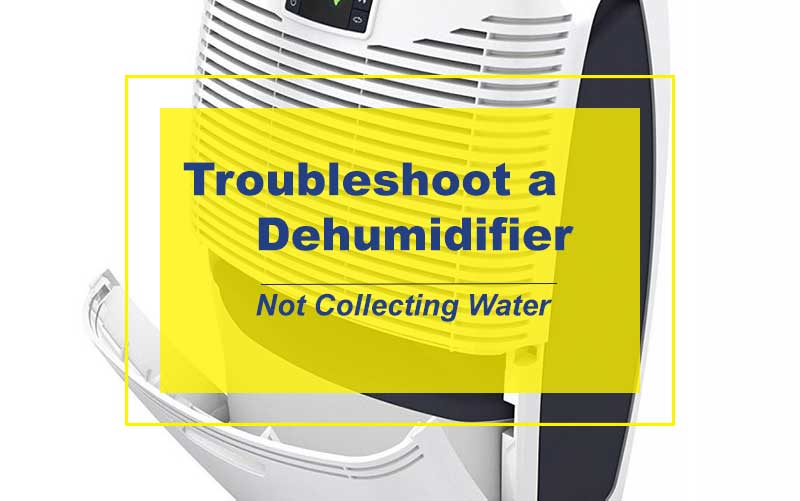As the relentless humidity of the season invades our homes, dehumidifiers emerge as our valiant warriors, battling against moisture and condensation. But what happens when these dependable appliances suddenly falter, leaving us with stagnant air and an uncomfortable environment? If your dehumidifier has ceased to collect water, this comprehensive guide will empower you with the knowledge and meticulous steps necessary to restore it to its water-absorbing glory.

Image: www.veranda-interiors.com
The Dehumidifier’s Inner Workings: An Expedition into Humidity Control
A dehumidifier operates on a fundamental principle: drawing in moist air, extracting excess moisture, and releasing drier air back into the room. This remarkable transformation is achieved through the collaboration of a compressor, condenser coils, and an evaporator coil. The humidity-laden air enters the dehumidifier’s intake, where it encounters the evaporator coil, chilled to temperatures below the air’s dew point. Condensation forms on the cold coils, separating the moisture from the air. The condensed water droplets then trickle down a collection tray and are subsequently stored in a reservoir. Simultaneously, the warm, dry air absorbs the heat from the condenser coils and is then released back into the room.
Diagnosing the Malaise: Unraveling the Causes of Dehumidifier Dysfunction
When your dehumidifier refuses to collect water, several culprits may be lurking behind its diminished performance. Identifying the precise cause is the first step towards an effective remedy:
- Clogged Air Filter: Just as clogged arteries impede blood flow, a dirty air filter obstructs the airflow necessary for dehumidification.
- Malfunctioning Compressor: This vital component pressurizes and circulates the refrigerant, the lifeblood of the dehumidification process. A faulty compressor can hinder the removal of moisture from the air.
- Frozen Evaporator Coil: Extreme cold can cause the evaporator coil to freeze over, preventing condensation from forming.
- Defective Fan Motor: The fan motor draws air through the dehumidifier and over the coils. If it fails, airflow is compromised, and dehumidification suffers.
- Damaged Condenser Coils: These coils release heat to dry the air. Damaged coils impair the dehumidifying efficiency.
- Full Water Tank: A full water tank can trip a sensor that signals the dehumidifier to stop collecting water.
- Power Issues: Insufficient power or a faulty connection can prevent the dehumidifier from operating altogether.
Restoring Hydration: A Step-by-Step Resuscitation Guide
With the underlying cause identified, it’s time to embark on the surgical intervention that will restore your dehumidifier to its moisture-absorbing prime:
- Unplug the Dehumidifier: Safety first! Always unplug the dehumidifier before initiating any maintenance or repairs.
- Clean the Air Filter: Locate the air filter and gently vacuum or rinse it with warm water. Allow it to dry completely before replacing it.
- Defrost a Frozen Evaporator Coil: If the evaporator coil is iced over, unplug the dehumidifier and allow it to thaw at room temperature for several hours or overnight.
- Reset the Dehumidifier: Once the issue has been resolved, reset the dehumidifier by unplugging it for a few minutes and then plugging it back in. This simple step often resolves minor glitches.
- Contact a Qualified Technician: If the issue persists despite your best efforts, it’s wise to seek the assistance of a qualified technician. They possess the expertise and specialized tools to diagnose and repair more complex problems.

Image: thehumidistat.com
How To Fix A Dehumidifier That Won’T Collect Water
https://youtube.com/watch?v=qTyjj5iroC8
Preventive Measures: Guarding Against Future Moisture Mishaps
Just as an ounce of prevention is worth a pound of cure, adopting proactive measures can safeguard your dehumidifier from future water collection woes:
- Regularly Clean the Air Filter: A clean air filter ensures optimal airflow, preventing strain on the dehumidifier.
- Keep Vents and Intakes Clear: Obstructions near the dehumidifier’s vents and intakes impede the flow of air, compromising performance.
- Avoid Overworking the Dehumidifier: Operating the dehumidifier in an excessively humid environment can lead to overworked components and reduced efficiency.
- Properly Size the Dehumidifier: Selecting a dehumidifier with the appropriate capacity for the room size prevents it from working too hard.
- Maintain Optimal Temperature: Dehumidifiers operate most effectively within a temperature range of 60°F to 80°F.